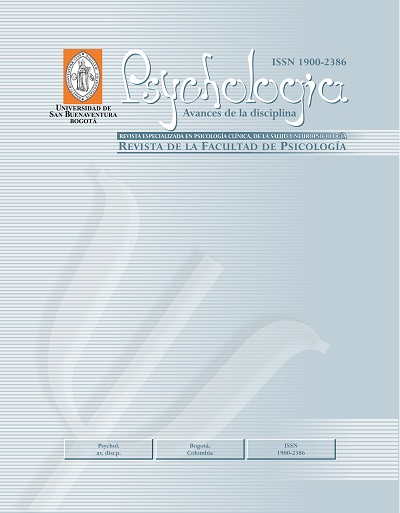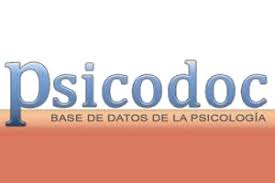View/Download
How to Cite
Ríos-Flórez, J. A., & Flórez-Barco, E. (2017). Theory of mind in children from 6 to 10 years old with premature birth condition and at a school age. Psychologia, 11(2), 29–43. https://doi.org/10.21500/19002386.2626
More Citation Formats
License terms
▼
This journal provides open, immediate access to its contents, based on the principle that offering the public free access to research helps to promote a higher global exchange of knowledge.
As such, all journal articles are published under a Creative Commons Attribution-NonCommercial-ShareAlike 4.0 International License (CC BY-NC-SA), by which commercial use of the original work or its possible derived works is not allowed, and the distribution thereof must be done with the same license elements regulating the original work.
http://creativecommons.org/licenses/by-nc-sa/4.0/
Abstract
This research paper has established the influence of premature birth on the function of theory of mind. Based on that, this research has taken a quantitative model. Participants who are part of the process are 160 children between six and 10 years old, and 80 of them were born premature and 80 non-premature infants in par condition. A protocol composed of eight questionnaires was developed to measure the various components of the ToM. Statistically significant differences were found between the two groups. These kind of cases affect people social development, sometimes this condition involves situations related to irony. At the same time, the particular condition presents difficulties in order to interpret people’s emotions or feelings, and facial expressions as well. Nonetheless, premature birth brought some particular characteristics that need to be under consideration during life time.
References
Adolphs, R., Tranel, D., Damasio, H. & Damasio, A.R (1995). Fear and the human amygdala. The Journal of Neuroscience, 15(9), 5879-5891. doi.org/10.1038/372669a0
Aguilera, E. C. y Ostrosky, F. (2013). Componentes del Temperamento y su Relacion con Funciones Ejecutivas en Tareas de Inhibición y Toma de Desiciones en niños. Revista Neuropsicología, Neuropsiquiatría y Neurociencias, 13(1), 15-26. http://feggylab.mex.tl/imagesnew/7/0/4/8/6/componentes.pdf
Ajayi-Obe, M., Saeed, N., Cowan, K., Rutherford, M. & Edwards, A. (2000). Reduced development of cerebral cortex in extremely preterm infants. Lancet, 30, 1162- 1163. doi.org/10.1016/s0140-6736(00)02761-6
Alexander, M.P., Benson, D.F. & Stuss, D. T. (1989). Frontal lobes and language. Brain Lang, 37(4), 656-691. doi.org/10.1016/0093-934x(89)90118-1
Baron-Cohen, S., Leslie, A.M. & Frith, U.( 1985). Does the autistic child have a ‘theory of mind’?. Cognition, 21, 37-46. doi.org/10.1016/0010-0277(85)90022-8
Baron-Cohen, S., Wheelwright, S. & Jolliffe, T. (1997). Is there a “language of the eyes”? Evidence from normal adults with autism or Asperger syndrome. Visual Cognition 4:311-331. doi.org/10.1080/713756761
Campos, J. J., Barrett, K. C., Lamb, M. E., Goldsmith, H. H., & Sternberg, C. (1983). Socio-emotional development. M. M. Haith & J. J. Campos Eds. Handbook of child psychology (Vol. 2, 783-915). Nueva York: Wiley.
Caron, A.J., Caron, R.F. & MacLean, D.J. (1988). Infant discrimination of naturalistic emotional expressions: The role of face and voice. Child Development, 59(3), 604- 16. doi.org/10.2307/1130560
Cooke, R.W. & Abemethy, L.J. (1999). Cranial magnetic resonance imaging and school performance in very low birth weight infants in adolescence. Archives of Disease in Childhood Fetal and Neonatal Edition, 81(2), 116-121. doi.org/10.1136/fn.81.2.f116
Davidson, R.J. & Slagter, H.A. (2000). Probing emotion in the developing brain: Functional neuroimaging in the assessment of the neural substrates of emotion in normal and disordered children and adolescents. Mental Retardation and Developmental Disabilities Research Reviews, 6(3), 166-170. doi.org/10.1002/1098-2779(2000)6:3%3C166::aid-mrdd3%3E3.3.co;2-f
De Haan, M. & Nelson, C.A. (1997). Recognition of the mother's face by six-month-old infants: a neurobehavioral study. Child Development, 68(2), 187-210. doi.org/10.1111/j.1467-8624.1997.tb01935.x
Donaldson, S. K. & Westerman, M. A. (1986). Development of children`s understanding of ambivalence and causal theories of emotion. Developmental Psichology 22 (5), 655-62. doi.org/10.1037/0012-1649.22.5.655
Gnepp, J. (1989). Personalized inferences of emotions and appraisals; Component procesesse and correlates. Developmental Psychology, 25, 277-288. doi.org/10.1037/0012-1649.25.2.277
Happé , F. G.( 1994). An advanced test of theory of mind: understanding of story characters’ thoughts and feelings by able autistic, mentally handicapped, and normal children and adults. Journal of Autism and Developmental Disorders, 24(2), 129-54. doi.org/10.1007/bf02172093
Harris, P. L., Johnson, C., Hutton, D., Andrews, G., & Cooke, T. (1989). Young children’s theory of mind and emotion. Cognition and Emotion, 3, 379-400. doi.org/10.1080/02699938908412713
Hernández, R., Fernández, C. y Baptista, M, P. (2014). Metodología de la investigación. México: Mc Graw Hill.
Iglesias, J. Loeches, A. y Serrano, J.M. (1989). Expresión facial y reconocimiento de emociones en lactantes. Infancia y Aprendizaje, 48, 93-113. doi.org/10.1080/02103702.1989.10822251
Inder, T., Hüppi, R., & Warfield, S. (1999). Periventricular white matter injury in the premature infant is followed by reduced cerebral cortical grey matter volume at term. Annals of Neurology, 46(5), 755- 60. doi.org/10.1002/1531-8249 (199911)46:5%3C755::aid-ana11%3E3.0.co;2-0
Kimberly, G. y Choherty, J. (2005). Identificación del recién nacido de alto riesgo y valoración de la edad gestacional. Prematuridad, hipermadurez, peso elevado y bajo peso para su edad gestacional. Manual de Cuidados Neonatales. Eds.
Choherty, J., Eichenwald, E. y Stark, A. 4ta ed. 3:50-66. Barcelona. https://www.aeped.es/sites/default/files/documentos/8_1.pdf
Ley 1090 del 2006. Código Deontológico y Bioético del Psicólogo, (2006). Congreso de la República, Colombia.
Ludemann, P. & Nelson, C.A. (1988). Categorical representation of facial expressions by 7-month-old infants. Developmental Psychology, 24(4), 492-501. doi.org/10.1037/0012-1649.24.4.492
Montague, D.P. & Walker-Andrews, A.S. (2001). Peekaboo: a new look at infants' perception of emotion expressions. Development Psychology, 37(6), 826-38. doi.org/10.1037/0012-1649.37.6.826
Musso, M. (2009). Evaluación de funciones ejecutivas en niños: análisis y adaptación de pruebas en un contexto escolar. Revista Iberoameticana de Diagnóstico y Evaluación Psicológica (RIDEP). No 27, Vol. 1, 157-178. http://www.aidep.org/03_ridep/R27/R278res.pdf
Nedelcu, D. y Buceta, M. (2012). El Perfil Cognitivo de los Niños con Trastorno de Asperger y Autismo de Alto Funcionamiento. Revista Iberoameticana de Diagnóstico y Evaluación Psicológica (RIDEP). Nº 34, Vol. 1, 103-116. http://www.aidep.org/03_ridep/R34/ART%205.pdf
Nelson, C.A. (1987). The recognition of facial expressions in the first two years of life: mechanisms of development. Child Development, 58(4), 889-909. doi.org/10.2307/1130530.
Nelson, C.A., Morse, P.A. & Leavitt, L.A. (1979). Recognition of facial expressions by seven-month-old infants. Child Development, 50(4), 1239-1242. doi.org/10.2307/1129358.
Organización Mundial de la Salud. (2013). Nacimientos prematuros. Centro de presa de la Organización Mundial de la Salud, nota descriptiva N° 363.
Oster, H. (1981). Recognition of emotional expression in infancy? M. Lamb y C. Sherrod Eds. Infant social cognition: empirical and theoretical considerations. (pp. 85-125). Nueva Jersey: Erlbaum. http://www.um.es/analesps/v20/v20_2/06-20_2.pdf
Perner, J., Leekam, S. & Wimmer H. (1994). Three-years-olds’ difficulty with false belief. British Developmental Psychology, 5(2), 125-137. doi.org/10.1111/j.2044-835x.1987.tb01048.x.
Peterson, B.S., Vohr, B., Staib, L.H., Cannistraci, C.J., Dolberg, A. & Schneider, K.C. (2000). Regional brain volume abnormalities and long-term cognitive outcome in preterm infants. JAMA, 284(15), 1939-1947. http://www.scielo.cl/scielo.php?script=sci_arttext&pid=S0718-48082007000200009
Premack, D. & Woodruff, G. (1978). Does chimpanzee have a theory of mind? Behavioral and Brain Sciences, 4(4), 9-30. doi.org/10.1017/s0140525x00076512.
Resolución No. 8430 de 1993. Normas Científicas, Técnicas y Administrativas para la Investigación en Salud. Ministerio de Salud, (2003). Colombia.
Reynolds C. R., & Kamphaus R. W. (2004). BASC: Sistema de evaluación de conductas para niños y adolescentes: manual. TEA ediciones. Tea. www.teaediciones.com.
Ríos-Flórez, J. A. & Cardona-Agudelo, V. (2016). Procesos de aprendizaje en niños de 6 a 10 años de edad con antecedente de nacimiento prematuro. Revista Latinoamericana de Ciencias Sociales, Niñez y Juventud, 14 (2), pp. 1071-1085. DOI:10.11600/1692715x.14213241115
Rodríguez, N., García, E., Gorriz, A. y Regal, R. (2002) ¿Cómo se estudia el desarrollo de la mente? Jornades de Foment de la Investigació. Universitat Jaume I. España. pp. 1-13. http://repositori.uji.es/xmlui/bitstream/handle/10234/80146/forum _2002_co.pdf?sequence=1&isAllowed=y
Schwartz, G. M., Izard, C. E. & Ansul, S. E. (1985). The 5- month-old’s ability to discriminate facial expressions of emotion. Infant Behaviour & Development, 8(1), 65-77. doi.org/10.1016/s0163-6383(85)80017-5.
Serrano, J.M., Iglesias, J. & Loeches, A. (1992). Visual discrimination and recognition of facial expressions of anger, fear, and surprise in 4- to 6-month-old infants. Developmental Psychobiology, 25(6), 411-25. doi.org/10.1002/dev.420250603.
Strayer, J. (1993). Children's concordant emotions and cognitions in response to observed emotions. Child Development, 64, 188-201. doi.org/10.1111/j.1467-8624.1993.tb02903.x.
Tirapu-Ustárroz, J., Pérez-Sayes, G., Erekatxo-Bilbao, M. y Pelegrín-Valero, C. (2007). ¿Qué es la teoría de la mente? REV NEUROL, 44(8), 479-489. http://neurologia.com/pdf/web/4408/x080479.pdf
Trujillo, N., & Pineda, P.A. (2008). Función ejecutiva en la investigación de los trastornos del comportamiento del niño y del adolescente. Revista Neuropsicologia, Neuripsiquitria y Neurociencias, 8(1), 77-94. http://www.mdp.edu.ar/psicologia//psico/secacademica/asignaturas/aprendizaje/Trastornos%20FE.pdf
Wimmer, H. y Perner, J. (1983). Beliefs about beliefs: representation and constraining function of wrong beliefs in young children’s understanding of deception. Cognition. 13, 103-128. doi.org/10.1016/0010-0277(83)90004-5.
Young-Browne, G., Rosenfeld, H. & Horowitz, F. (1979). Infant discrimination of facial expressions. Child Development. 48(2), 555-562. doi.org/10.2307/1128653.
Aguilera, E. C. y Ostrosky, F. (2013). Componentes del Temperamento y su Relacion con Funciones Ejecutivas en Tareas de Inhibición y Toma de Desiciones en niños. Revista Neuropsicología, Neuropsiquiatría y Neurociencias, 13(1), 15-26. http://feggylab.mex.tl/imagesnew/7/0/4/8/6/componentes.pdf
Ajayi-Obe, M., Saeed, N., Cowan, K., Rutherford, M. & Edwards, A. (2000). Reduced development of cerebral cortex in extremely preterm infants. Lancet, 30, 1162- 1163. doi.org/10.1016/s0140-6736(00)02761-6
Alexander, M.P., Benson, D.F. & Stuss, D. T. (1989). Frontal lobes and language. Brain Lang, 37(4), 656-691. doi.org/10.1016/0093-934x(89)90118-1
Baron-Cohen, S., Leslie, A.M. & Frith, U.( 1985). Does the autistic child have a ‘theory of mind’?. Cognition, 21, 37-46. doi.org/10.1016/0010-0277(85)90022-8
Baron-Cohen, S., Wheelwright, S. & Jolliffe, T. (1997). Is there a “language of the eyes”? Evidence from normal adults with autism or Asperger syndrome. Visual Cognition 4:311-331. doi.org/10.1080/713756761
Campos, J. J., Barrett, K. C., Lamb, M. E., Goldsmith, H. H., & Sternberg, C. (1983). Socio-emotional development. M. M. Haith & J. J. Campos Eds. Handbook of child psychology (Vol. 2, 783-915). Nueva York: Wiley.
Caron, A.J., Caron, R.F. & MacLean, D.J. (1988). Infant discrimination of naturalistic emotional expressions: The role of face and voice. Child Development, 59(3), 604- 16. doi.org/10.2307/1130560
Cooke, R.W. & Abemethy, L.J. (1999). Cranial magnetic resonance imaging and school performance in very low birth weight infants in adolescence. Archives of Disease in Childhood Fetal and Neonatal Edition, 81(2), 116-121. doi.org/10.1136/fn.81.2.f116
Davidson, R.J. & Slagter, H.A. (2000). Probing emotion in the developing brain: Functional neuroimaging in the assessment of the neural substrates of emotion in normal and disordered children and adolescents. Mental Retardation and Developmental Disabilities Research Reviews, 6(3), 166-170. doi.org/10.1002/1098-2779(2000)6:3%3C166::aid-mrdd3%3E3.3.co;2-f
De Haan, M. & Nelson, C.A. (1997). Recognition of the mother's face by six-month-old infants: a neurobehavioral study. Child Development, 68(2), 187-210. doi.org/10.1111/j.1467-8624.1997.tb01935.x
Donaldson, S. K. & Westerman, M. A. (1986). Development of children`s understanding of ambivalence and causal theories of emotion. Developmental Psichology 22 (5), 655-62. doi.org/10.1037/0012-1649.22.5.655
Gnepp, J. (1989). Personalized inferences of emotions and appraisals; Component procesesse and correlates. Developmental Psychology, 25, 277-288. doi.org/10.1037/0012-1649.25.2.277
Happé , F. G.( 1994). An advanced test of theory of mind: understanding of story characters’ thoughts and feelings by able autistic, mentally handicapped, and normal children and adults. Journal of Autism and Developmental Disorders, 24(2), 129-54. doi.org/10.1007/bf02172093
Harris, P. L., Johnson, C., Hutton, D., Andrews, G., & Cooke, T. (1989). Young children’s theory of mind and emotion. Cognition and Emotion, 3, 379-400. doi.org/10.1080/02699938908412713
Hernández, R., Fernández, C. y Baptista, M, P. (2014). Metodología de la investigación. México: Mc Graw Hill.
Iglesias, J. Loeches, A. y Serrano, J.M. (1989). Expresión facial y reconocimiento de emociones en lactantes. Infancia y Aprendizaje, 48, 93-113. doi.org/10.1080/02103702.1989.10822251
Inder, T., Hüppi, R., & Warfield, S. (1999). Periventricular white matter injury in the premature infant is followed by reduced cerebral cortical grey matter volume at term. Annals of Neurology, 46(5), 755- 60. doi.org/10.1002/1531-8249 (199911)46:5%3C755::aid-ana11%3E3.0.co;2-0
Kimberly, G. y Choherty, J. (2005). Identificación del recién nacido de alto riesgo y valoración de la edad gestacional. Prematuridad, hipermadurez, peso elevado y bajo peso para su edad gestacional. Manual de Cuidados Neonatales. Eds.
Choherty, J., Eichenwald, E. y Stark, A. 4ta ed. 3:50-66. Barcelona. https://www.aeped.es/sites/default/files/documentos/8_1.pdf
Ley 1090 del 2006. Código Deontológico y Bioético del Psicólogo, (2006). Congreso de la República, Colombia.
Ludemann, P. & Nelson, C.A. (1988). Categorical representation of facial expressions by 7-month-old infants. Developmental Psychology, 24(4), 492-501. doi.org/10.1037/0012-1649.24.4.492
Montague, D.P. & Walker-Andrews, A.S. (2001). Peekaboo: a new look at infants' perception of emotion expressions. Development Psychology, 37(6), 826-38. doi.org/10.1037/0012-1649.37.6.826
Musso, M. (2009). Evaluación de funciones ejecutivas en niños: análisis y adaptación de pruebas en un contexto escolar. Revista Iberoameticana de Diagnóstico y Evaluación Psicológica (RIDEP). No 27, Vol. 1, 157-178. http://www.aidep.org/03_ridep/R27/R278res.pdf
Nedelcu, D. y Buceta, M. (2012). El Perfil Cognitivo de los Niños con Trastorno de Asperger y Autismo de Alto Funcionamiento. Revista Iberoameticana de Diagnóstico y Evaluación Psicológica (RIDEP). Nº 34, Vol. 1, 103-116. http://www.aidep.org/03_ridep/R34/ART%205.pdf
Nelson, C.A. (1987). The recognition of facial expressions in the first two years of life: mechanisms of development. Child Development, 58(4), 889-909. doi.org/10.2307/1130530.
Nelson, C.A., Morse, P.A. & Leavitt, L.A. (1979). Recognition of facial expressions by seven-month-old infants. Child Development, 50(4), 1239-1242. doi.org/10.2307/1129358.
Organización Mundial de la Salud. (2013). Nacimientos prematuros. Centro de presa de la Organización Mundial de la Salud, nota descriptiva N° 363.
Oster, H. (1981). Recognition of emotional expression in infancy? M. Lamb y C. Sherrod Eds. Infant social cognition: empirical and theoretical considerations. (pp. 85-125). Nueva Jersey: Erlbaum. http://www.um.es/analesps/v20/v20_2/06-20_2.pdf
Perner, J., Leekam, S. & Wimmer H. (1994). Three-years-olds’ difficulty with false belief. British Developmental Psychology, 5(2), 125-137. doi.org/10.1111/j.2044-835x.1987.tb01048.x.
Peterson, B.S., Vohr, B., Staib, L.H., Cannistraci, C.J., Dolberg, A. & Schneider, K.C. (2000). Regional brain volume abnormalities and long-term cognitive outcome in preterm infants. JAMA, 284(15), 1939-1947. http://www.scielo.cl/scielo.php?script=sci_arttext&pid=S0718-48082007000200009
Premack, D. & Woodruff, G. (1978). Does chimpanzee have a theory of mind? Behavioral and Brain Sciences, 4(4), 9-30. doi.org/10.1017/s0140525x00076512.
Resolución No. 8430 de 1993. Normas Científicas, Técnicas y Administrativas para la Investigación en Salud. Ministerio de Salud, (2003). Colombia.
Reynolds C. R., & Kamphaus R. W. (2004). BASC: Sistema de evaluación de conductas para niños y adolescentes: manual. TEA ediciones. Tea. www.teaediciones.com.
Ríos-Flórez, J. A. & Cardona-Agudelo, V. (2016). Procesos de aprendizaje en niños de 6 a 10 años de edad con antecedente de nacimiento prematuro. Revista Latinoamericana de Ciencias Sociales, Niñez y Juventud, 14 (2), pp. 1071-1085. DOI:10.11600/1692715x.14213241115
Rodríguez, N., García, E., Gorriz, A. y Regal, R. (2002) ¿Cómo se estudia el desarrollo de la mente? Jornades de Foment de la Investigació. Universitat Jaume I. España. pp. 1-13. http://repositori.uji.es/xmlui/bitstream/handle/10234/80146/forum _2002_co.pdf?sequence=1&isAllowed=y
Schwartz, G. M., Izard, C. E. & Ansul, S. E. (1985). The 5- month-old’s ability to discriminate facial expressions of emotion. Infant Behaviour & Development, 8(1), 65-77. doi.org/10.1016/s0163-6383(85)80017-5.
Serrano, J.M., Iglesias, J. & Loeches, A. (1992). Visual discrimination and recognition of facial expressions of anger, fear, and surprise in 4- to 6-month-old infants. Developmental Psychobiology, 25(6), 411-25. doi.org/10.1002/dev.420250603.
Strayer, J. (1993). Children's concordant emotions and cognitions in response to observed emotions. Child Development, 64, 188-201. doi.org/10.1111/j.1467-8624.1993.tb02903.x.
Tirapu-Ustárroz, J., Pérez-Sayes, G., Erekatxo-Bilbao, M. y Pelegrín-Valero, C. (2007). ¿Qué es la teoría de la mente? REV NEUROL, 44(8), 479-489. http://neurologia.com/pdf/web/4408/x080479.pdf
Trujillo, N., & Pineda, P.A. (2008). Función ejecutiva en la investigación de los trastornos del comportamiento del niño y del adolescente. Revista Neuropsicologia, Neuripsiquitria y Neurociencias, 8(1), 77-94. http://www.mdp.edu.ar/psicologia//psico/secacademica/asignaturas/aprendizaje/Trastornos%20FE.pdf
Wimmer, H. y Perner, J. (1983). Beliefs about beliefs: representation and constraining function of wrong beliefs in young children’s understanding of deception. Cognition. 13, 103-128. doi.org/10.1016/0010-0277(83)90004-5.
Young-Browne, G., Rosenfeld, H. & Horowitz, F. (1979). Infant discrimination of facial expressions. Child Development. 48(2), 555-562. doi.org/10.2307/1128653.
Downloads
Download data is not yet available.





















